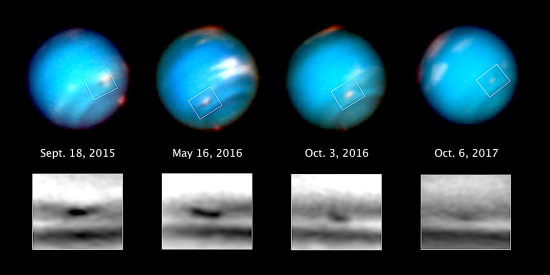
The first images of this dark vortex are from the Outer Planet Atmospheres Legacy (OPAL) program, a long-term Hubble project that annually captures global maps of our solar system’s four outer planets. Credit: NASA, ESA, and M.H. Wong and A.I. Hsu (UC Berkeley).
Feb 19, 2018
Neptune’s clouds contradict consensus viewpoints.
On July 12, 2011 Neptune completed its first orbit around the Sun since it was discovered on September 23, 1846. This means that observations are limited, since great distance strains technology’s ability. Spectrographic data about Neptune, for instance, is limited to the last 30 years, or so.
Neptune is the eighth planet and farthest from the Sun. Its diameter is around 49,250 kilometers. Neptune is a massive planet, with an approximate orbital radius of 4.4 billion kilometers, and a year of 164.79 Earth years. Its high gravity means that its escape velocity is close to 85,000 kilometers per hour. In comparison, escape velocity from Earth is 42,168 kilometers per hour.
Neptune is never more than seventh magnitude in brightness, so it is invisible to the naked eye. Urbain Le Verrier predicted a hypothetical eighth planet beyond Uranus, because of the orbital anomalies he saw in Jupiter, Saturn, and Uranus. Johann Galle and Heinrich d’Arrest found the planet based on Le Verrier’s data.
A previous Picture of the Day reported the discovery of a ten Celsius temperature difference between the overall temperature of Neptune and its south polar region. Astronomers think that the Sun’s heat initiates a convective flow of methane around the planet, causing warmer gas within those convective streams to rise into the cloud tops. Indeed, according to observations by the Hubble Space Telescope, Neptune’s atmosphere could be more thermally active than its sisters, Saturn and Jupiter.
Electrical disturbances on Neptune generate radio noise. Those energetic forces also push eruptions of gases from its lower atmosphere into the stratosphere. Those massive lightning discharges form electrical conduits that connect Neptune’s ionosphere and magnetosphere with the Sun’s environment. Telescopic spectroscopes see warm upwelling in the atmosphere and interpret those as thermal convection. However, the strongest winds in the Solar System on the planet farthest from the Sun contradict any thermal convection models. On Neptune, a place so cold that nitrogen, oxygen, and argon could freeze into solids, winds around the Great Dark Spot are moving at almost 2000 kilometers per hour.
In an Electric Universe, Neptune’s hot storms, hot poles, 2000 kilometer per hour winds, and atmospheric banding indicate an electrically active planet connected to the Sun’s circuit. It is principally electrical energy and not internal thermal energy that powers Neptune’s winds. Conventional theory cannot adequately explain the data. Understanding Neptune will help planetary scientists better understand weather systems on Earth.
Stephen Smith












